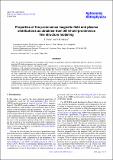Files in this item
Properties of the prominence magnetic field and plasma distributions as obtained from 3D whole-prominence fine structure modeling
Item metadata
| dc.contributor.author | Gunar, Stanislav | |
| dc.contributor.author | Mackay, Duncan Hendry | |
| dc.date.accessioned | 2016-07-25T11:30:08Z | |
| dc.date.available | 2016-07-25T11:30:08Z | |
| dc.date.issued | 2016-08 | |
| dc.identifier | 243133761 | |
| dc.identifier | 4b24954f-69c0-4551-b194-4bcf24948335 | |
| dc.identifier | 84979992237 | |
| dc.identifier | 000384722600053 | |
| dc.identifier.citation | Gunar , S & Mackay , D H 2016 , ' Properties of the prominence magnetic field and plasma distributions as obtained from 3D whole-prominence fine structure modeling ' , Astronomy & Astrophysics , vol. 592 , A60 . https://doi.org/10.1051/0004-6361/201527704 | en |
| dc.identifier.issn | 0004-6361 | |
| dc.identifier.other | ORCID: /0000-0001-6065-8531/work/58055447 | |
| dc.identifier.uri | https://hdl.handle.net/10023/9203 | |
| dc.description.abstract | Aims. We analyze distributions of the magnetic field strength and prominence plasma (temperature, pressure, plasma beta, and mass) using the 3D whole-prominence fine structure model. Methods. The model combines a 3D magnetic field configuration of an entire prominence, obtained from non-linear force-free field simulations, with a detailed semi-empirically derived description of the prominence plasma. The plasma is located in magnetic dips in hydrostatic equilibrium and is distributed along multiple fine structures within the 3D magnetic model. Results. We show that in the modeled prominence, the variations of the magnetic field strength and its orientation are insignificant on scales comparable to the smallest dimensions of the observed prominence fine structures. We also show the ability of the 3D whole-prominence fine structure model to reveal the distribution of the prominence plasma, with respect to its temperature within the prominence volume. This provides new insights into the composition of the prominence-corona transition region. We further demonstrate that the values of the plasma beta are small throughout the majority of the modeled prominence when realistic photospheric magnetic flux distributions and prominence plasma parameters are assumed. While this is generally true, we also find that in the region with the deepest magnetic dips, the plasma beta may increase towards unity. Finally, we show that the mass of the modeled prominence plasma is in good agreement with the mass of observed non-eruptive prominences. | |
| dc.format.extent | 10 | |
| dc.format.extent | 7214003 | |
| dc.language.iso | eng | |
| dc.relation.ispartof | Astronomy & Astrophysics | en |
| dc.subject | Sun: filaments, prominences | en |
| dc.subject | Sun: magnetic fields | en |
| dc.subject | Plasmas | en |
| dc.subject | Methods: numerical | en |
| dc.subject | QB Astronomy | en |
| dc.subject | QC Physics | en |
| dc.subject | NDAS | en |
| dc.subject.lcc | QB | en |
| dc.subject.lcc | QC | en |
| dc.title | Properties of the prominence magnetic field and plasma distributions as obtained from 3D whole-prominence fine structure modeling | en |
| dc.type | Journal article | en |
| dc.contributor.sponsor | Science & Technology Facilities Council | en |
| dc.contributor.sponsor | The Leverhulme Trust | en |
| dc.contributor.institution | University of St Andrews. Applied Mathematics | en |
| dc.identifier.doi | https://doi.org/10.1051/0004-6361/201527704 | |
| dc.description.status | Peer reviewed | en |
| dc.date.embargoedUntil | 2017-06-25 | |
| dc.identifier.grantnumber | ST/N000609/1 | en |
| dc.identifier.grantnumber | RPG-305 | en |
This item appears in the following Collection(s)
Items in the St Andrews Research Repository are protected by copyright, with all rights reserved, unless otherwise indicated.

